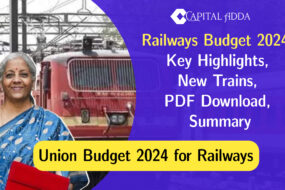
S&P Global Ratings, a leading credit rating agency, has upgraded India’s sovereign rating outlook from stable to positive while maintaining the rating at ‘BBB-‘. This decision, announced on Wednesday, highlights India’s robust economic growth and improved quality of government expenditure. But why is this upgrade significant, and what does it mean for India’s future?

Understanding Credit Ratings
What Are Credit Ratings?
Credit ratings are assessments of a country’s creditworthiness, indicating the risk level of investing in that country. Higher ratings often lead to lower borrowing costs and greater investor confidence.
Role of S&P Global Ratings
S&P Global Ratings is crucial in the global financial system, providing independent credit ratings, risk evaluations, and analytics. These assessments help investors, governments, and financial institutions make informed decisions.
Details of the Upgrade
Current Rating and Outlook
S&P has revised India’s rating outlook to positive from stable, affirming the long-term rating at ‘BBB-‘ and the short-term rating at ‘A-3’. This places India at the lowest investment-grade level but signals potential for future upgrades.

Historical Context
The last time S&P upgraded India’s rating outlook was in 2010, from negative to stable. This recent change marks a significant improvement, reflecting ongoing economic reforms and growth.
Reasons for the Upgrade
Robust Economic Growth
India’s consistent and strong economic growth has been a major factor behind the upgrade. The economy’s resilience and recovery from the pandemic-induced slowdown have impressed rating agencies and investors.
Improved Quality of Government Expenditure
The Indian government’s efforts to improve the efficiency and transparency of its spending have paid off. Initiatives like the Goods and Services Tax (GST) and Direct Benefit Transfer (DBT) have enhanced spending quality and reduced wastage.
Impact on India’s Economy
Potential for Rating Upgrade
S&P has indicated that it could further upgrade India’s rating in the next two years if the country adopts cautious fiscal and monetary policies. This could help reduce the government’s debt and interest burden while boosting economic resilience.
Effects on Foreign Investment
A positive rating outlook boosts investor confidence, likely leading to increased foreign direct investment (FDI). This influx can spur economic growth and development, enhancing India’s global standing.
Influence on Domestic Markets
The upgrade can positively impact domestic markets, lowering borrowing costs for businesses and encouraging local investments. Improved market sentiment can drive consumer confidence and spending, further fueling economic growth.
S&P’s Criteria for Future Upgrades
Fiscal and Monetary Policy Expectations
S&P expects India to maintain prudent fiscal and monetary policies. This includes managing deficits effectively and keeping debt levels sustainable, which are crucial for future upgrades.
Debt and Interest Burden Management
A significant reduction in the fiscal deficit and government debt, particularly if it falls below 7% of GDP structurally, is essential. Effective management of these factors can alleviate India’s weak public finances and improve its rating.
Comparing India’s Rating with Other Economies
India’s Position Relative to Global Peers
India’s economic policies and growth rates position it favorably among emerging markets. Compared to other BRICS nations, India’s proactive reforms and robust growth give it an edge.
Comparison with Fitch and Moody’s Ratings
While S&P has revised India’s outlook to positive, Fitch and Moody’s still maintain a stable outlook. This distinction highlights the different perspectives and criteria used by rating agencies.
Government Spending in India
Historical Spending Patterns
Historically, India’s government spending has focused on infrastructure, social welfare, and defense. However, inefficiencies and corruption often limited the effectiveness of these expenditures.
Recent Improvements and Initiatives
Recent initiatives have significantly improved the quality of government spending. Programs aimed at enhancing transparency and reducing leakages have ensured that funds are better utilized for their intended purposes.
Economic Reforms and Infrastructure Investment
Key Economic Reforms
India has implemented key economic reforms, including changes in taxation, labor laws, and the financial sector. These reforms have created a more conducive environment for business and investment.
Focus on Infrastructure Development
The government’s focus on infrastructure investment has been pivotal. High public investment in infrastructure is expected to drive economic growth and improve the country’s long-term growth prospects.
Monetary Policy and Inflation Management
Role of the Central Bank
The Reserve Bank of India (RBI) plays a crucial role in managing the country’s monetary policy and controlling inflation. Its policies are vital for maintaining economic stability and growth.
Strategies for Inflation Control
Effective management of inflation is essential for economic stability. The RBI’s strategies, including interest rate adjustments and liquidity management, aim to keep inflation at manageable levels over time.
Challenges Ahead
Economic Challenges
Despite the positive outlook, India faces economic challenges such as managing inflation, addressing unemployment, and ensuring equitable growth. Balancing rapid growth with sustainability is critical.
Political and Social Challenges
Political stability and social harmony are vital for sustained economic growth. Addressing issues such as inequality and access to essential services like education and healthcare is crucial for holistic development.
Future Outlook
Predictions for India’s Economy
Experts predict robust growth for India, driven by its young population, technological advancements, and ongoing reforms. The focus on digital transformation and renewable energy is expected to open new growth avenues.
Expected Changes in Government Policies
The government is likely to continue its reform agenda, enhancing the ease of doing business, improving infrastructure, and fostering innovation. Policies to boost manufacturing and exports and attract more FDI will be key drivers of future growth.
Expert Opinions
Analysts’ Views on the Upgrade
Analysts view the upgrade as a validation of India’s economic policies and growth prospects. They believe the positive outlook will enhance India’s credibility in global financial markets, attracting more investments.
Economic Experts on India’s Future
Economic experts are optimistic about India’s future, citing strong fundamentals and a reform-oriented government. Maintaining reform momentum and addressing structural challenges are essential for sustained long-term growth.
Public and Market Reactions
Response from Indian Markets
The Indian markets have responded positively to the upgrade, reflecting increased investor confidence. This optimism is likely to drive further investments and economic activity.
Public Opinion on the Upgrade
Public opinion has also been favorable, with many viewing the upgrade as a sign of India’s improving economic health and future prospects.
Read More: Nvidia’s stock (NASDAQ: NVDA) Forecast & Price Target
Conclusion
India’s rating outlook upgrade by S&P Global Ratings underscores the country’s robust economic growth and improved government spending quality. While challenges remain, the positive outlook reflects confidence in India’s policy stability, economic reforms, and long-term growth prospects. Continued focus on fiscal discipline, infrastructure investment, and inflation management will be key to sustaining this positive momentum.
FAQs
What Does a Credit Rating Upgrade Mean?
A credit rating upgrade indicates an improved assessment of a country’s creditworthiness, which can lead to lower borrowing costs and increased investor confidence.
How Will This Upgrade Affect the Common Citizen?
The upgrade can boost economic growth, leading to more job opportunities and potentially lower borrowing costs for consumers and businesses.
What Are the Next Steps for India?
India needs to maintain prudent fiscal and monetary policies, continue its reform agenda, and focus on sustainable economic growth to further improve its rating.
How Often Are Credit Ratings Updated?
Credit ratings are typically reviewed annually but can be updated more frequently if significant economic or political developments occur.
Can India’s Rating Be Downgraded Again?
Yes, if economic conditions deteriorate or fiscal and monetary policies are not managed effectively, the rating could be downgraded in the future.




